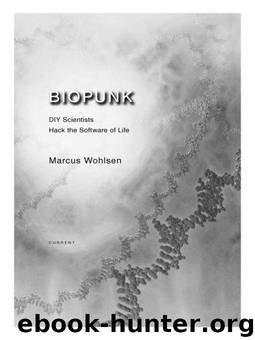Biopunk: DIY Scientists Hack the Software of Life by Wohlsen Marcus

Author:Wohlsen, Marcus [Wohlsen, Marcus]
Language: eng
Format: mobi
Publisher: Penguin Group
Published: 2011-04-13T16:00:00+00:00
CHAPTER 11
Reading
In the 1980s, he stalked the streets of one of Los Angeles’s poorest neighborhoods strangling and gunning down women—seven in all before the shooting stopped, at least for a while. Starting in 2002, the murders began again. The press called him the Grim Sleeper because of the long gap between killing sprees. Investigators had leads, but the detectives on the streets never nailed their man.
Meanwhile, hundreds of miles north in Richmond, California, another impoverished city that knows its share of killing, government gene jockeys in a lab were running a routine check when something unusual popped up. In a practice known as familial DNA search, the state-run lab was comparing the DNA of a man recently convicted of a felony weapons charge to DNA profiles stored in a California crime database. Against the objections of privacy advocates, California law enforcement officials in 2008 began searching for genetic similarities between convicts’ DNA and stored DNA evidence from unsolved crimes. Instead of just looking for direct matches, investigators also started to seek similar Y chromosomes, which are shared among male relatives. Matching Ys might link not just convicts but sons, uncles, brothers, and nephews to crime scenes.
In this case, thirty-one-year-old Christopher Franklin’s DNA partially matched samples recovered at several Grim Sleeper crime scenes. Suspicion turned to Franklin’s father, fifty-seven-year-old Lonnie Franklin, Jr. Agents staked him out, swiped a pizza crust he had thrown away as they followed him, and from it lifted a current DNA sample. The sample matched. Investigators said Lonnie Franklin Jr. was the Grim Sleeper. He has pleaded not guilty.
The use of familial DNA search to catch a serial killer was one of the most Hollywood-ready uses of comparative genomics to date. But law enforcement hardly has a monopoly on the technology used to track him down. For as little as $149, anyone with an Internet connection can order the same test used to catch Franklin from Ancestry .com to track down “genetic cousins.” The site claims customers can use the results to trace paternal ancestors dating as far back as one hundred thousand years.
Once the exclusive realm of high-end science and homicide investigations, DNA has become part of the everyday. The grandly expensive and decade-long Human Genome Project has in less than a decade yielded to fast, cheap sequencers that can decode anyone’s DNA for the price of a cheap used car. (Many in the field believe that within ten years the cost of getting an entire human genome sequenced will close in on zero.) Societies have only just started to digest the implications of this dramatic change in what we can know about our biological selves. Yet a growing group of not just biopunks but regular consumers have decided what unbridled access to DNA means to them. They want to know more—about themselves, about others, about every living thing—and life not yet imagined. And they do not want to wait for anyone else to tell them what they can and cannot know.
As the opportunity to know
Download
This site does not store any files on its server. We only index and link to content provided by other sites. Please contact the content providers to delete copyright contents if any and email us, we'll remove relevant links or contents immediately.
Enlightenment Now: The Case for Reason, Science, Humanism, and Progress by Steven Pinker(7172)
A Journey Through Charms and Defence Against the Dark Arts (Harry Potter: A Journey Through…) by Pottermore Publishing(4773)
The Immortal Life of Henrietta Lacks by Rebecca Skloot(4504)
A Journey Through Divination and Astronomy by Publishing Pottermore(4332)
Elon Musk by Ashlee Vance(4007)
Origin Story: A Big History of Everything by David Christian(3633)
COSMOS by Carl Sagan(3539)
Alchemy and Alchemists by C. J. S. Thompson(3435)
Enlightenment Now by Steven Pinker(3324)
Bad Pharma by Ben Goldacre(3291)
Shadow of Night by Deborah Harkness(3278)
Inferior by Angela Saini(3262)
A Mind For Numbers: How to Excel at Math and Science (Even If You Flunked Algebra) by Barbara Oakley(3206)
Origin Story by David Christian(3133)
Signature in the Cell: DNA and the Evidence for Intelligent Design by Stephen C. Meyer(3057)
The Code Book by Simon Singh(3056)
The Elements by Theodore Gray(2982)
A Brief History of Time by Stephen Hawking(2947)
A Journey Through Potions and Herbology (A Journey Through…) by Pottermore Publishing(2818)
